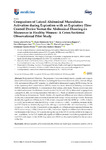Mostrar el registro sencillo del ítem
Comparison of Lateral Abdominal Musculature Activation during Expiration with an Expiratory Flow Control Device Versus the Abdominal Drawing-in Maneuver in Healthy Women : A Cross-Sectional Observational Pilot Study
| dc.contributor.author | Abuín-Porras, Vanesa | |
| dc.contributor.author | Maldonado-Tello, Paula | |
| dc.contributor.author | Cueva Reguera, Mónica de la | |
| dc.contributor.author | Rodríguez Sanz, David | |
| dc.contributor.author | Calvo-Lobo, César | |
| dc.contributor.author | López-López, Daniel | |
| dc.contributor.author | Navarro Flores, Emmanuel | |
| dc.contributor.author | Romero Morales, Carlos | |
| dc.date.accessioned | 2020-03-02T17:24:35Z | |
| dc.date.available | 2020-03-02T17:24:35Z | |
| dc.date.issued | 2020-02 | |
| dc.identifier.citation | Abuín-Porras, V.; Maldonado-Tello, P.; de la Cueva-Reguera, M.; Rodríguez-Sanz, D.; Calvo-Lobo, C.; López-López, D.; Navarro-Flores, E.; Romero-Morales, C. Comparison of Lateral Abdominal Musculature Activation during Expiration with an Expiratory Flow Control Device Versus the Abdominal Drawing-in Maneuver in Healthy Women: A Cross-Sectional Observational Pilot Study. Medicina 2020, 56, 84. | es_ES |
| dc.identifier.issn | 1010-660X | |
| dc.identifier.uri | http://hdl.handle.net/2183/25077 | |
| dc.description.abstract | [Abstract] Background and Objectives: The purpose of the present study was to quantify and compare lateral abdominal musculature thickness, including the transverse abdominis (TrA), internal oblique (IO), and external oblique (EO) muscles, via rehabilitative ultrasound imaging (RUSI) during the use of the expiratory flow control device (EFCD) versus the classic abdominal drawing-in maneuver (ADIM). Materials and Methods: A cross-sectional observational pilot study. Twenty-one women were recruited and assessed the thickness of each muscle (TrA, IO, and EO) by ultrasound imaging at rest, during the ADIM, and during expiration with the EFCD. Waist circumference was also measured under the same circumstances. Results: Statistically significant differences were observed between ADIM, EFCD, and at rest condition for the thickness of the TrA (p = 0.001) and IO (p = 0.039). Moreover, statistically significant differences for TrAb at rest compared with the ADIM (p = 0.001, Cohen’s d = 2.183) and at rest and with the EFCD (p = 0.001, Cohen’s d = 2.843). In addition, between ADIM and EFCD were not statistically significant, although a moderate effect size was found (p = 0.055, Cohen’s d = 0.694). For the IO muscle thickness, significant differences were reported between the EFCD and at rest (p = 0.038), Cohen’s d = 0.081). Conclusions: Significant differences in the increase of the thickness of the TrA and IO muscles during the use of the EFCD and the ADIM with respect to rest. In addition, for the TrA, statistically significant differences were found during expiration with the EFCD with respect to the ADIM. Expiration with EFCD can be a useful method for the activation of the TrA. | es_ES |
| dc.language.iso | eng | es_ES |
| dc.publisher | MDPI AG | es_ES |
| dc.relation.uri | https://doi.org/10.3390/medicina56020084 | es_ES |
| dc.rights | Atribución 3.0 España | es_ES |
| dc.rights.uri | http://creativecommons.org/licenses/by/3.0/es/ | * |
| dc.subject | Ultrasonography | es_ES |
| dc.subject | Abdominal muscles | es_ES |
| dc.subject | Abdominal drawing-in maneuver | es_ES |
| dc.subject | Muscle activity | es_ES |
| dc.title | Comparison of Lateral Abdominal Musculature Activation during Expiration with an Expiratory Flow Control Device Versus the Abdominal Drawing-in Maneuver in Healthy Women : A Cross-Sectional Observational Pilot Study | es_ES |
| dc.type | journal article | es_ES |
| dc.rights.accessRights | open access | es_ES |
| UDC.journalTitle | Medicina | es_ES |
| UDC.volume | 56 | es_ES |
| UDC.issue | 2 | es_ES |
| UDC.coleccion | Investigación | es_ES |
| UDC.departamento | Ciencias da Saúde | es_ES |
| UDC.grupoInv | Grupo de Investigación Saúde e Podoloxía (GISAP) | es_ES |
Ficheros en el ítem
Este ítem aparece en la(s) siguiente(s) colección(ones)
-
Investigación (FEP) [507]






